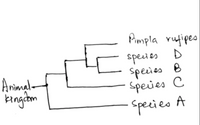
Concept explainers
Pimpla rufipes
Species A: possess a calcium carbonate shell and is found in marine environments
Species B: Segmented worm, marine and possess bristles known as ‘setae’
Species C: Bioluminescent, possess special cells known as colloblasts which are attached to tentacles
Species D:
(photo of the phylogenetic tree here)
B.1 Does P. rufipes engage in incomplete or catastrophic metamorphosis? _________________
B.2. Explain why you chose your answer for B.1.
__________________________________________________________________________________
B.3. List ONE (1) advantage of the developmental strategy you chose above?

Trending nowThis is a popular solution!
Step by stepSolved in 2 steps

- Can you answer all the parts of this question about this picture A: This structure belongs to an organism from what phylum? - Answer choices: Mollusca, Nemertea, Platyhelminthes, Rotifera B: What is the structure shown above?arrow_forwardWhich group is correctly paired with its description? A. diatoms-important consumers in aquatic communities B. diplomonads-protists with modified mitochondria C. apicomplexans -producers with intricate life cycles D. red algae-acquired plastids by secondary endosymbiosisarrow_forwardHow can scientists determine that multicellularity arose more than once in different lineages? Select one: a. Scientists do not know b. Bacteria live as multicellular groups called biofilms c. Animals are more closely related to single-celled eukaryotes than to fungi d. Fungi can produce multicellular structuresarrow_forward
- Put characteristics on this phylogenetic tree.arrow_forwardImagine you come across an animal with a worm-like biody. Determine whether it is a polychaete or a member of class Hirudinida? Give two distinct differences between the two without naming the same structure/invisible features of each animal (e.g animal x has 2 wings, animal y has 4 wings are not distinct differences)arrow_forwardCould you explain this:arrow_forward
- Based on the phylogenies presented in your book, which of the following could best be described as the most closely related to rats? fungi green algae slime molds alveloata Giardiaarrow_forwardBased on the table, explain why there are more similarities between humans and chimpanzees than between humans and dogs.arrow_forwardSponges are highly ancestral animals. One unique property found in sponges that is not present in vertebrates is; Sexual reproduction totipotent cells which can transform into other cell types specialized stinging cells photosynthesisarrow_forward
 Human Anatomy & Physiology (11th Edition)BiologyISBN:9780134580999Author:Elaine N. Marieb, Katja N. HoehnPublisher:PEARSON
Human Anatomy & Physiology (11th Edition)BiologyISBN:9780134580999Author:Elaine N. Marieb, Katja N. HoehnPublisher:PEARSON Biology 2eBiologyISBN:9781947172517Author:Matthew Douglas, Jung Choi, Mary Ann ClarkPublisher:OpenStax
Biology 2eBiologyISBN:9781947172517Author:Matthew Douglas, Jung Choi, Mary Ann ClarkPublisher:OpenStax Anatomy & PhysiologyBiologyISBN:9781259398629Author:McKinley, Michael P., O'loughlin, Valerie Dean, Bidle, Theresa StouterPublisher:Mcgraw Hill Education,
Anatomy & PhysiologyBiologyISBN:9781259398629Author:McKinley, Michael P., O'loughlin, Valerie Dean, Bidle, Theresa StouterPublisher:Mcgraw Hill Education, Molecular Biology of the Cell (Sixth Edition)BiologyISBN:9780815344322Author:Bruce Alberts, Alexander D. Johnson, Julian Lewis, David Morgan, Martin Raff, Keith Roberts, Peter WalterPublisher:W. W. Norton & Company
Molecular Biology of the Cell (Sixth Edition)BiologyISBN:9780815344322Author:Bruce Alberts, Alexander D. Johnson, Julian Lewis, David Morgan, Martin Raff, Keith Roberts, Peter WalterPublisher:W. W. Norton & Company Laboratory Manual For Human Anatomy & PhysiologyBiologyISBN:9781260159363Author:Martin, Terry R., Prentice-craver, CynthiaPublisher:McGraw-Hill Publishing Co.
Laboratory Manual For Human Anatomy & PhysiologyBiologyISBN:9781260159363Author:Martin, Terry R., Prentice-craver, CynthiaPublisher:McGraw-Hill Publishing Co. Inquiry Into Life (16th Edition)BiologyISBN:9781260231700Author:Sylvia S. Mader, Michael WindelspechtPublisher:McGraw Hill Education
Inquiry Into Life (16th Edition)BiologyISBN:9781260231700Author:Sylvia S. Mader, Michael WindelspechtPublisher:McGraw Hill Education





